Elsaß |
|
|
|
| Übersicht – Contents: | |
Elsaß |
|
|
|
| Übersicht – Contents: | |
Flaggen – Flags: |
|
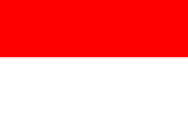 |
Flagge des Elsaß – flag of Alsace – drapeau de Alsace, in Verwendung – in use, Seitenverhältnis – ratio = 3:5, Quelle/Source, nach/by: biblioweb.hypotheses.org |
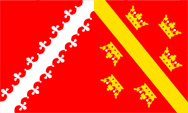 |
1948-2003, inoffizielle Flagge der Region Elsaß (1960–2016) - unofficial flag of the Alsace Region (1960–2016) - drapeau officieux de la région Alsace (1960–2016), Quelle/Source, nach/by: Die Welt der Flaggen |
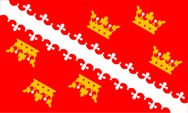 |
2003–2016, inoffizielle Flagge der Region Elsaß (1960–2016) - unofficial flag of the Alsace Region (1960–2016) - drapeau officieux de la région Alsace (1960–2016), Quelle/Source, nach/by: Wikipedia (D) |
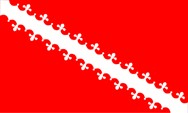 |
Flagge der Landgrafschaft Unterelsaß - flag of the Landgraviate of Lower Alsace - Drapeau du Landgraviat de Basse Alsace |
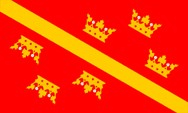 |
Flagge der Landgrafschaft Oberelsaß - flag of the Landgraviate of Upper Alsace - Drapeau du Landgraviat de Haute Alsace |
Bedeutung/Ursprung der Flagge – Meaning/Origin of the Flag: |
|
| Die historische Flagge des Elsass ist eine Wappenflagge, ihr Design von 1948 zeigt eine nebeneinander stehende Kombination der Heraldik der Wappen der Landgrafschaften Oberelsass und Unterelsass. | The historic flag of Alsace is a scutcheon-flag, its design from 1948 shows a side-by-side arrangement of the coats of arms of the Landgraviates of Upper Alsace and Lower Alsace. |
| Die zwischen 1960 und 2016 bestehende Region Elsass verwendete ab 2003 eine inoffizielle Flagge, welche Merkmale der historischen Flaggen von Ober- und Unterelsass anders kombiniert. | The between 1960 an 2016 existing Region of Alsace used from 20036 an unofficial flag, which combined the features of the flags of Upper Alsace and of Lower Alsace in an other way. |
| Quelle/Source: Volker Preuß, Wikipedia (D), biblioweb.hypotheses.org | |
| Wappen – Coat of arms: | |
 |
Wappen des Elsass – coat of arms of Alsace – blason de Alsace, Quelle/Source, nach/by: Heraldique Europeenne |
 |
Wappen von Oberelsass – coat of arms of Upper Alsace – blason de Haute
Alsace, Quelle/Source, nach/by: Heraldique Europeenne |
 |
Wappen von Unterelsass – coat of arms of Lower Alsace – blason de Basse
Alsace, Quelle/Source, nach/by: Heraldique Europeenne |
Bedeutung/Ursprung des Wappens – Meaning/Origin of the Coat of Arms: |
|
| Das Wappen des Elsass ist eine Kombination der Wappen der Landgrafschaften Oberelsass und Unterelsass. | The coat of arms of Alsace is a combination of the coats of arms of the Landgraviates of Upper Alsace and Lower Alsace. |
| Beide Wappenschilde sind rot, beide zeigen einen Schrägrechtsbalken, beim Oberelsass ist er golden, beim Unterelsass silbern, wobei die Kanten beim Unterelsass im Lilienschnitt dargestellt sind. Das Wappen des Oberelsass zeigt zusätzlich noch je drei goldene Kronen in den Freiräumen auf beiden Seiten des Balkens. | Both escutcheons are red, both show an slant right bar, for Upper Alsace, it is golden, for Lower Alsace, it is sivery, but the edges in Lower Alsace show a lily cut. The coat of arms of Upper Alsace shows additionally three golden crowns in the free spaces on both sides of the bar. |
| Quelle/Source: Volker Preuß, Heraldique Europeenne | |
|
Die Regionen: Die historischen, französischen Regionen – The historical, french Regions |
|
|
in Schwarz: Provinz und Gouvernement im Jahre 1776, in Rot: ehemalige
Grafschaft, Provinz oder Gouvernement – in black: governorate and province in 1776, in red: former county, province oder governorate |
| Landkarte/Map: Volker Preuß |
| Erläuterungen zu den Regionen | Explanation about the Regions |
| Die bis zur Französischen Revolution bestehenden Provinzen (bzw. Gouvernements) waren historisch gewachsene Gebilde, die sich oft aus ehemaligen Lehensgebieten der französischen Krone, historischen Grafschaften und Herzogtümern heraus entwickelt hatten, oft über hunderte von Jahren bestanden und Regionalität (kulturelle Besonderheiten und regionale Sprachen) bewahrt hatten. Der Französischen Revolution waren solche Erscheinungen natürlich nicht erwünscht, und im Rahmen ihrer blutigen und gewalttätigen Gleichmacherei wurden jegliche regionale Bezüge ausgemerzt. Kurz nach der Revolution wurden die Provinzen aufgelöst und Frankreich in viele kleine Départements aufgeteilt, die annähernd gleich groß und den gleichen Status haben sollten. Benannt wurden die Départements nach Flüssen oder Gebirgen, um auf keinen Fall den Namen einer der alten Provinz zu verwenden. Es gelang jedoch nicht, die Verbindungen der Einwohner Frankreichs zu ihrer jeweiligen Region abzuschneiden, so dass im Jahre 1960 wieder administrative Regionen geschaffen wurden, um bestimmte Verwaltungsprozesse regional steuern zu können. Dazu wurden Départements, die in einer bestimmten historischen Provinz lagen, zu einer historisch oft gleichnamigen Region administrativ zusammengefasst. Die dabei entstandenen Gebilde decken sich nur annähernd mit den Grenzen der historischen Provinzen. Im streng zentralistischen Frankreich wird jedwede Regionalität vermieden, so dass auch die offiziellen Flaggen dieser Regionen meist aussehen wie Flaggen von Firmen, lieblos, unhistorisch, technokratisch und modernistisch, die hier nicht Gegenstand lexikalischer Betrachtungen sein sollen. Nur in wenigen dieser Regionen gibt es offizielle Flaggen die an historische Vorbilder erinnern. Aber, sogar die Existenz dieser heutigen Regionen ist in Frage gestellt, denn im Jahr 2014 wurde eine Gebietsreform beschlossen, welche die Anzahl der Regionen ab dem Jahr 2016 durch Fusionen auf fast die Hälfte verringert. Jedoch gibt es für fast alle Regionen inoffizielle Flaggen, die an die alten Provinzen und die alte Heraldik erinnern sollen. | The until
the French Revolution existing provinces (or governorates) have been
historically grown structures, which had their roots oftenly in former
fiefdoms of the French crown, historic counties and duchies. They oftenly
existed for hundreds of years and had preserved regionality (e.g. cultural
particularities and regional languages). On the occasion of the French
Revolution such phenomena were of course not desirable, and as part of their
bloody and violent egalitarianism any regional references were eliminated. Shortly after the French Revolution the provinces were dissolved and France became divided into many départements, which should have approximately the same size and the same status. The départements were named after rivers or mountains, to use never and in no circumstances the name of an old province. However, there was no success in cutting the connections of the people of France to their respective regions, so that administrative regions were re-created in 1960, to have a better control in regional administrative processes. In this way became départements, which were placed in a historical province, administratively grouped to an oftenly historically named region. The resulted structures coincide only approximately with the boundaries of the old provinces. In the strictly centralist France any regionality is avoided, so that even the official flags of these regions mostly look like flags of companies, unloving, unhistorical, technocratic and modernistic, and these flags should not be a subject of any lexical considerations here. Only in a few of that regions, exist official flags which remember the historical models. But, even the existence of these today's regions is douptful, because in 2014 was passed a territorial reform valid from the year 2016, that reduces the number of the existing regions by merging to nearly the half. However, there exist unofficial flags in nearly all of these regions, which should remember the old provinces and the old heraldry. |
|
Wikipedia-Link zu den Regionen Frankreichs:
hier klicken FOTW-Link zu den Regionen Frankreichs: hier klicken |
Wikipedia
Link to the regions of France:
click here FOTW Link to the regions of France: click here |
| Quelle/Source: Flags of the World, Wikipedia (D), Volker Preuß | |
Geschichte: |
|
1. Jhd. v.Chr.
· zwischen Vogesen und Rhein siedeln germanische Stämme (Troboker, Nemeter,
Vangionen), im äußersten Süden auch Kelten (Sequaner, Rauriker) 55 v.Chr. · der römische Feldherr und spätere Diktator Caesar erobert Gallien, ebenso die Gebiete der Germanen zwischen Vogesen und Rhein, die größtenteils der Provinz Germania Superior angeschlossen werden 3.–5. Jhd. n.Chr. · Angriffe und Eindringen der Alemannen über den Rhein 5. Jhd. · die Alemannen siedeln zu beiden Seiten des Rheins 534 · die Franken erobern das Gebiet der Alemannen, das Gebiet zwischen Vogesen und Rhein bekommt den Namen "Elsaß", Christianisierung 7. Jhd. · Herausbildung des Herzogtums Elsaß unter dem Frankenkönig Pippin 814 · Tod von Karl dem Großen (König der Franken und Römischer Kaiser) 843 · Erbstreitigkeiten, Vertrag von Wirten (Verdun), das Frankenreich wird unter den drei Enkeln Karls des Großen aufgeteilt, Elsass kommt an Lothar I. 870 · Vertrag von Meersen, Elsaß kommt an das Reich Ludwigs II. 879/880 · Verträge von Wirten (Verdun) und Ribemont, Elsaß kommt an das Reich Ludwigs III., das Ostfränkische Reich 10.–12. Jhd. · Elsaß gehört im Deutschen Reich zum Herzogtum Schwaben 12. Jhd. · das Elsaß zerfällt in kleine Herrschaften und Landgrafschaften, die direkt dem deutschen König und Kaiser unterstehen, sowie in städtische Gebiete (spätere Reichsstädte), die Landgrafschaft Oberelsaß (Südelsaß, Sundgau) kommt an die Grafen von Habsburg, die Landgrafschaft Unterelsaß (Nordelsaß) kommt an die Grafen von Öttingen 1365–1375 · Invasion plündernder, marodierender, französischer Soldaten 14. Jhd. · die Macht der Grafen von Öttingen verfällt, viele Territorien werden an das Bistum Straßburg verkauft 1444 · französische Truppen besetzen Oberelsaß 1445 · französische Truppen greifen Straßburg und Mülhausen an 1469–1477 · Karl der Kühne de Valois, Herzog von Burgund, pachtet die Habsburger Besitzungen im Oberelsaß, trifft jedoch auf erbitterten Widerstand der Elsäßer, er fällt 1477 in der Schlacht von Nanzig (Nancy) 1523–1529 · Ausbreitung der Reformation 1552 · König Heinrich II. von Frankreich bemächtigt sich der Bistümer Metz, Toul und Verdun 1617 · die habsburgischen Besitzungen im Oberelsaß kommen an die spanische Linie der Habsburger 1648 · Ende des 30-jährigen Krieges, Westfälischer Friede, Frankreich bekommt die spanischen Besitzungen im Oberelsass zugesprochen 17.–18. Jhd. · Frankreich gewinnt Schritt für die Oberherrschaft im Elsaß, nur Mühlhausen, Saarwerden und Salm verbleiben beim Heiligen Römischen Reich Deutscher Nation 1776 · die schon im 14. Jahrhundert geschaffenen Gouvernements der Zivilverwaltung des Königreiches Frankreich werden auf eine Anzahl von 39 Stück festgeschrieben und entsprechen so der Anzahl der Provinzen, in den Vorjahren konnten auch mehrere Provinzen in einem Gouvernement zusammengefasst sein 1789 · Französische Revolution, die Gouvernements und Provinzen werden abgeschafft, das Elsaß wird in Départements zerlegt (im wesentlichen Bas-Rhin und Haut-Rhin) 1792–1805 · Angriffe französischer Revolutionsarmeen auf das Deutsche Reich, Frankreich besetzt im Jahre 1797 alle deutschen Territorien westlich des Rheins 1801 · Frieden von Lunéville, das Heilige Römische Reich Deutscher Nation tritt offiziell alle linksrheinischen Reichsgebiete an das Frankreich Napoléons ab 1813 · Völkerschlacht bei Leipzig, Niederlage Napoleons, österreichische und russische Truppen setzen den Franzosen in den Elsaß nach und stoßen auf Widerstand in der Bevölkerung 1852 · Louis Napoléon wird als Napoléon III. Kaiser von Frankreich, Aufbau eines französischen, kulturellen Drucks gegenüber den Deutschen im Elsaß, Versuch der Zurückdrängung der deutschen Sprache, die Elsäßer können jedoch ihre kulturelle Eigenart innerhalb Frankreichs bewahren 1870–1871 · Deutsch-Französischer Krieg, Niederlage Frankreichs, Frankreich muss Elsaß und Teile Lothringens an das Deutsche Reich abtreten, die Elsäßer sind wenig begeistert, Angliederung als 'Reichsland Elsaß-Lothringen' an das Deutsche Reich 1871–1873 · unmittelbare Regierung durch den Bundesrat des Deutschen Reichs 1874 · erste Wahlen zum Deutschen Reichstag, Bildung eines Landesausschusses für Elsaß-Lothringen 1879 · Einsetzung eines Statthalters als Oberhaupt des Reichslandes Elsaß-Lothringen 1911 · das Land erhält eine eigene Verfassung und wird den übrigen deutschen Bundesstaaten gleichgestellt, Wahl des ersten und einzigen Landtags des Reichslandes Elsaß-Lothringen 1914–1918 · Erster Weltkrieg, die Westfront verläuft durch den Oberelsaß 11.11.1918 · Waffenstillstand von Compiègne, Elsaß-Lothringen ist innerhalb von 15 Tagen von deutschen Truppen zu räumen, mit dem Abzug der deutschen Truppen bildet sich die Republik Elsass-Lothringen, die sich in eine kommunistische Räterepublik wandelte, gegen die französische Truppen zu Hilfe gerufen werden 17.–21.11.1918 · französische Truppen marschieren in Mülhausen, Colmar, Metz und Straßburg ein 17.10.1919 · Auflösung des Landes Elsaß-Lothringen durch Frankreich, 200.000 nach dem Jahr 1870 zugewanderte Deutsche werden vertrieben, nach Einspruch der USA durfe die Hälfte zurückkehren 1919–1940 · französische Assimilationspolitik gegen die Deutsche Bevölkerung fördert wachsenden Unmut und Unzufriedenheit 1939–1945 · Zweiter Weltkrieg, am 19.06.1940 besetzt die Deutsche Wehrmacht Elsaß-Lothringen, das Land wird zwar in die Reichsverwaltung und in NSDAP-Gaue integriert jedoch nicht dem Deutschen Reich angeschlossen, es kommt zur Vertreibung einiger Franzosen aus dem Land, 1942 wird die Wehrpflicht eingeführt, Einberufungen in die Deutsche Wehrmacht und die Waffen-SS, Januar 1945: alliierte Truppen erreichen Elsaß-Lothringen, Wiedererrichtung der französischen Verwaltung, erneutes Einsetzen französischer Assimilationspolitik 1960 · Wiedereinführung von Regionen in Frankreich, Bildung der Region Elsass, jedoch nicht innerhalb historischer Grenzen sondern durch Einbindung der Departements Bas-Rhin und Haut-Rhin 2016 · die Region Elsass (Alsace) geht zusammen mit den Regionen Champagne-Ardennen und Lothringen (Lorraine) in der neuen größeren Region Großer Osten (Grand Est) auf |
History: |
|
1st century B.C. · between Vogesen Mountains and Rhine River settle
Germanic tribes (Troboker, Nemeter, Vangiones), in the south also Celts
(Sequani, Rauriker) 55 B.C. · Caesar, the Roman general and future dictator conqueres Gaul, as well as the territories of the Germans between the Vogesen Mountains and Rhine River, most become annexed to the Province of Germania Superior 3rd to 5th century A.D. · attacks and invasions of the Alemanni across the Rhine 5th century · the Alemanni settle on both sides of Rhine River 534 · the Franks conquer the territory of the Alemanni, the region between the Vogesen Mountains and Rhine River receives the name "Elsass", Christianization 7th century · formation of the Duchy of Elsass under the Frankish king Pippin 814 · death of Charles the Great (King of the Franks and Holy Roman Emperor) 843 · inheritance disputes, Treaty of Wirten (Verdun), the Frankish kingdom is divided among the three grandsons of Charles the Great, Elsass comes to Lothair I. 870 · Treaty of Meersen, Elsass comes to the realm of Ludwig II. 879/880 · Treaties of Wirten (Verdun) and Ribemont, Elsass comes to the kingdom of Louis III., the Eastern Frankish Empire 10th to 12th century · Elsass belongs in the German Empire to the Duchy of Swabia 12th century · Elsass becomes divided into small principalities and landgraviates, which are directly subordinated to the German King and Emperor, as well as in urban areas (later imperial cities), the Landgraviate of Upper Elsass (Southern Elsass, Sundgau) comes to the Counts of Habsburg, the Landgraviate of Lower Elsass (Northern Elsass ) comes to the Counts of Oettingen 1365–1375 · invasion of looting, marauding, French soldiers 14th century · the power of the Counts of Oettingen expires, many territories are sold to the Diocese of Strassburg 1444 · French troops occupy Upper Elsass (Elsass in French = Alsace) 1445 · French troops attack Strassburg and Muehlhausen 1469–1477 · Charles the Bold de Valois, Duke of Burgundy leases the Habsburg possessions in Upper Alsace, but gets fierce resistance of Alsatians, he fall in 1477 in the Battle of Nanzig (Nancy) 1523–1529 · expansion of the Lutheran reformation 1552 · King Henry II. of France seizes the Bishoprics of Metz, Toul and Verdun 1617 · the Habsburg possessions in Upper Alsace come to the Spanish line of the Habsburgs 1648 · end of the 30-years War, Peace of Westphalia, France gets awarded the Spanish possessions in Upper Alsace 17th to 18th century · France wins step for step the supremacy in Alsace, only the towns of Muehlhausen, Saarwerden and Salm remain in the Holy Roman Empire of German Nation 1776 · the already in the 14th century created governorates of the civil administration of the kingdom of France become committed to a number of 39, and correspond in this way to the number of provinces, in previous years could any provinces be summarized in one governorate 1789 · French Revolution, the governorates (provinces) become abolished, Alsace is divided into departments (essentially Bas-Rhin and Haut-Rhin) 1792–1805 · French revolutionary armies attack the German Empire, France occupies in 1797 all the German territories west of the Rhine 1801 · Peace of Luneville, the Holy Roman Empire of German Nation cedes officially all areas of the left bank of the River Rhine to Napoléon's French Empire 1813 · Battle of Leipzig, Napoléon's defeat, Austrian and Russian troops follow the French trough the Alsace and see resistance in the population 1852 · Louis Napoleon becomes Emperor of France as Napoléon III., onset of a French cultural pressure against the Germans in Alsace, trial to suppress the German language, but the Alsatians can preserve their cultural identity within France 1870–1871 · German-French War, France's defeat, France has to cede Alsace and parts of Lorraine to the German Empire, the Alsatians are not so enthusiastic, affiliation as 'Imperial Province of Alsace-Lorraine' to the German Empire 1871–1873 · direct government by the Federal Council of the German Empire 1874 · first elections to the German parliament, formation of a National Committee for Alsace-Lorraine 1879 · installation of a governor as head of Alsace-Lorraine 1911 · the country gets its own constitution and gets equality among the other German states, first and last election for the parliament (Landtag) of Alsace-Lorraine 1914–1918 · First World War, the western front passes through Upper Alsace 11th of November 1918 · Armistice of Compiègne, Alsace-Lorraine is to vacate by German troops within 15 days, with the withdrawal of the German troops, the Republic of Alsace-Lorraine was proclaimed, but startet to transform into a Soviet Republic, French troops were called in to help, who finished the Soviet Republic 17th–21st of November 1918 · French troops marching in, in Muehlhausen (Mulhouse), Colmar, Metz and Strassburg (Strasbourg) 17th of October in 1919 · dissolution of Alsace-Lorraine by France, 200.000 after 1870 immigrated Germans have to leave the country, after an appeal of the USA it was allowed to return for the half 1919–1940 · French assimilation policy towards the German population causes growing discontent and dissatisfaction 1939–1945 · Second World War, on 19th of June in 1940 the German Wehrmacht occupies Alsace-Lorraine, the country becomes integrated into the German administration and into the NSDAP-districts, but becomes not officially re-annexed to the German Empire, it comes to expulsions of some French out of the country, in 1942 introduce of conscription, conscriptions into the German Wehrmacht and the Waffen-SS, January 1945: Allied troops reach Alsace-Lorraine, re-establishment of the French administration, once more onset of the French policy of assimilation 1960 · reintroduction of regions in France, formation of the Region of Alsace, but not within the historic boundaries, just by integrating of the departments of Bas-Rhin and Haut-Rhin 2016 · the Alsace (Elsass) region merges with the Champagne-Ardenne and Lorraine (Lothringen) regions in the new, larger region of Greater East (Grand Est) |
| Quelle/Source: Meyers Konversationslexikon, Atlas zur Geschichte, Wikipedia (D) |
Ursprung des Landesnamens – Origin of the Country's Name: |
|
| Der Ursprung des Namens "Elsaß" geht auf die Zeit der Frankenherrschaft zurück. Es gibt zwei Erklärungen: Der Name kommt von dem Wort "Elisassen", was "fremde Bewohner" heißt (Sassen = Einwohner), bzw. vom Wort "Illsassen", was die "Bewohner der Ufers der Ill" heißt. Die Ill (ILL) ist ein Fluss, der im zentralen Elsaß parallel zum Rhein fließt und 10 km nördlich von Straßburg in den Rhein mündet. Auf französisch heißt das Land "Alsace". | The origin of the name "Alsace" goes back to the period of the Frankish rule. There are two explanations: The name comes from the word "Elisassen" which means "foreign residents" (sassen = inhabitants), or from the word "Illsassen" what means: "the inhabitants of the banks of the Ill". The Ill (ILL) is a river that flows parallel to the Rhine in central Alsace, and flows into the Rhine 10 km north of Strasbourg. In French the land is called "Alsace". |
| Quelle/Source: Meyers Konversationslexikon | |